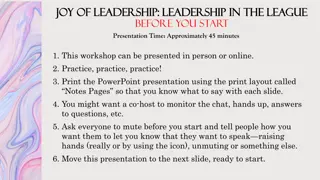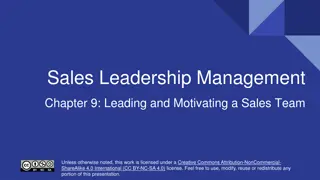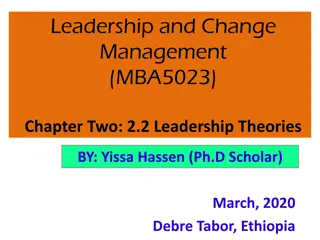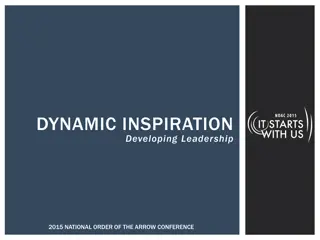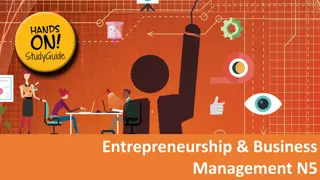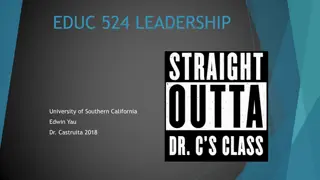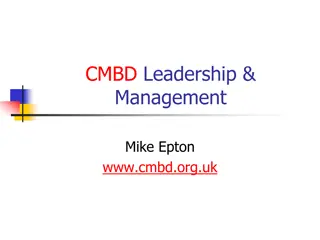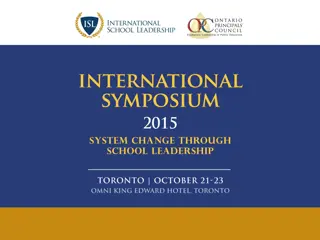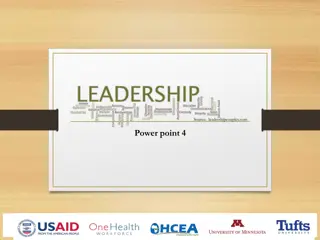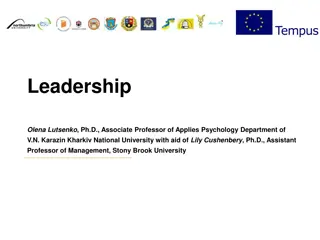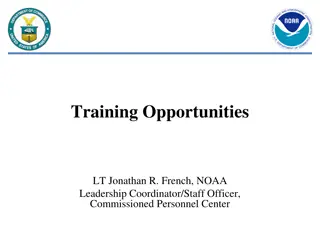
Leadership and Management: Key Concepts and Theories
Explore the fundamental differences between leadership and management, including their roles, characteristics, and theories. Discover how traits and behaviors contribute to successful leadership, and delve into various leadership theories such as contingency theory, trait theory, and behavioral theory.
Download Presentation

Please find below an Image/Link to download the presentation.
The content on the website is provided AS IS for your information and personal use only. It may not be sold, licensed, or shared on other websites without obtaining consent from the author. If you encounter any issues during the download, it is possible that the publisher has removed the file from their server.
You are allowed to download the files provided on this website for personal or commercial use, subject to the condition that they are used lawfully. All files are the property of their respective owners.
The content on the website is provided AS IS for your information and personal use only. It may not be sold, licensed, or shared on other websites without obtaining consent from the author.
E N D
Presentation Transcript
LEADERSHIP Leadership is a part of influencing, motivating and directing the members in such a way, so that there will be willingness, co-operation, participating among the member to achieve their goal or task. confidence and
WHO IS FAVOURITE WHO IS FAVOURITE LEADER LEADER ? ?
FEATURES : I. It can be formal or informal II. A group phenomenon III.Interaction between 2 or more people IV.Dynamic art
IS THERE IS ANY DIFFERENCE BETWEEN LEADER & MANAGER OR LEADERSHIP & MANAGEMENT (MANAGERSHIP) ?
Leaders has followers, but managers have sub-ordinates. Leadership managership is always formal. can be formal or informal, whereas Managership arises within the organization whereas leadership occurs anywhere. Manger gets power from authority of the organization whereas leader gets power from his followers. Manager may or may not influence or motivate his subordinates whereas leaders have the ability to influence his followers.
The main aim of manger is to achieve organizational objective, whereas leader s main objective/aim is to satisfy the need of his followers. Manger manages things whereas leader lead people. Leadership is doing right things, whereas managership is doing things in right way. Management work as a ladder for success, whereas leadership is the wall which support the ladder.
THEORIES OF LEADERSHIP THEORIES OF LEADERSHIP Leadership Theory CONTIGENCY THEORY TRAIT THEORY BEHAVIORIAL THEORY Fiedler theory Path goal theory Situational theory Ohio state university University of Michigan study Managerial Grid LMX
TRAIT THEORY Traditional theory Focus on the individual characteristic of successful and unsuccessful leader.
CONTINUE. Traits for successful leader are: - Emotional stability, Good physical appearance, Technical knowledge, Sociable, Fore sightedness, Ability to influence others, Willingness to work along with people, Alert, Problem solver etc. Similarly unsuccessful leader also causes few traits as per this theory:- Poor temperament, Self-centered, Lack of vision, Lack of sense of decision making, Inability to work along with people etc.
BEHAVIOURAL THEORY A. The Ohio State of University Leaders behaviour Initiating Structure (I) Consideration (C)
B. THE UNIVERSITY OF MICHIGAN STUDY 2 types of leader: Employees centered (employee oriented)& Task centered (task oriented leader)
C. MANAGERIAL GRID Develop by Blake and Mountain 2 dimensions: Concern for people & Concern for production 5 types of leadership: A. 9,1-TASK MANAGEMENT B. 1,9- COUNTRY CLUB MANAGEMENT C.5,5- MIDDLE OF ROAD MANAGEMENT D. 9,9- TEAM MANAGEMENT E. 1,1- IMPROVISE MANAGEMNT
D. LEADER MEMBER EXCHANGE THEORY Also known as LMX Theory. 2 group: In Group & Out Group
CONTIGENCY THEORY A. FIEDLER S THEORY Task Motivati onal style of Leader orientation Relation orientation Effectiven ess of Leader Leader member relation Favouable ness of situaition Task structure Position power
B. PATH GOAL THEORY Developed by Robert House
C. SITUAITIONAL THEORY Also known as Hersey-Blanchard situational leadership theory. Developed by Hershey & Blanchard. 2 types of leader behaviour: Task behaviour & Relation behaviour.
CONTEMPORARY THEORY Behavioural theory Contingency theory Transformational theory Transactional theory
TRANSFORMATIO NAL THEORY 1. followers by providing them with a sense of meaning and challenge. teamwork and commitment. consistent vision, mission, and a set of values to the members. Inspirational Motivation-leaders guide foster the promotion spirit of of
2. Intellectual Stimulation: leaders: encourage their followers to be innovative and creative. They encourage new ideas from their followers and never criticize them in public. 3. Idealized Influence: leaders act as role models for its followers. Win the trust and respect from the followers. 4. Individualized Consideration: Leaders act as mentors to their followers and reward them for creativity and innovation. The followers are treated differently according to their talents and knowledge.
TRANSACTIONAL THEORY By Max Weber in 1947. based on the idea that managers give employees something they want in exchange for getting something they want. Leader give task to follwers motivation can be drawn through system of reward and punishment
STYLE OF LEADERSHIP Laisser-Fairz Style Autocratic Style Participative Style Transformational Style Transactional Leadership
LAISSER-FAIRZ STYLE AUTOCRATIC STYLE Also known as Authoritarian style of leadership. Here, the manager takes all the decisions. The manager holds the total authority and imposes it on their employees. No one change the decision of the leader. Only communication is here. This supervision is fit for those employees who need close supervision. It is also known free rain style, which means leave alone. In this type of leader, is lack in direct supervision to their employees. He failed regular feedback. Give maximum freedom is allowed. This style is good for highly experienced trained employees to provide downward
PARTICIPATIVE STYLE TRANSFORMATIONAL LEADERSHIP focused on employees to innovate, and shape the future of the organizational structure Leader associated growth oriented organization It focus on organizational change. Motivate the team members to work beyond their comfort zone. Possess high level of integrity, emotional intelligence, vision of the communication skill. It is also known as motivation create for democratic leadership style. change, Here the leader allows and encourage their employees to participate and involve in decision making process. with high It is a popular style of leadership followers get emotionally attached to the project and leader performance. because shared good future, for better
TRANSACTIONAL LEADERSHIP Transactional leadership styles are more concerned with maintaining the normal flow of operations. use disciplinary power and an array of incentives to motivate employees to perform at their best. Transactional means motivate the subordinate by exchanging reward performance. known as managerial leadership Transactional leaders punishments to motivate their followers. utilize rewards and

